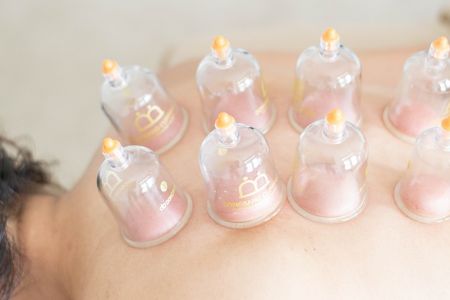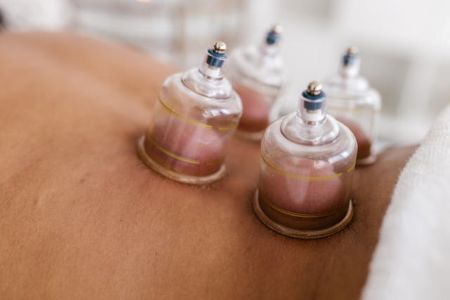Theoretical Rationale & Mechanisms of Action
This section delineates the theoretical underpinnings of the proposed integrative pain management protocol, detailing the individual mechanisms of action for each component – simultaneous high and low frequency Transcutaneous Electrical Nerve Stimulation (TENS), concurrent electroacupuncture, and follow-up cupping therapy – and, critically, articulating the rationale for their synergistic application.

Simultaneous High & Low Frequency TENS
Transcutaneous Electrical Nerve Stimulation (TENS) is a non-invasive electrotherapy technique that delivers electrical stimulation through the skin to modulate pain. Its mechanisms of action are complex and appear to be frequency-dependent (Johnson, 2014).
High-Frequency TENS (80-100 Hz)
- High-frequency TENS is primarily thought to activate Aβ (beta) nerve fibers, which are large-diameter, myelinated fibers that transmit non-painful sensory information. This activation is believed to contribute to pain relief through the “gate control theory” of pain (Melzack & Wall, 1965). The gate control theory proposes that stimulation of these Aβ fibers can “close the gate” at the level of the spinal cord’s dorsal horn, inhibiting the transmission of nociceptive signals carried by Aδ (delta) and C fibers, thereby providing rapid analgesia (Dubin, A. E., & Patapoutian, A. (2010). Nociceptors: the sensors of pain. The Journal of clinical investigation, 120(11), 3760–3772.). This mechanism is often associated with the provision of analgesia during the stimulation period.
Low-Frequency TENS (1-20 Hz)
- Low-frequency TENS, on the other hand, is thought to engage different mechanisms, primarily involving the activation of Aδ fibers. This activation is proposed to stimulate the release of endogenous opioids, such as beta-endorphins, enkephalins, and dynorphins, within the central nervous system (CNS), including the spinal cord and supraspinal structures (Han, J. S. (2004). Acupuncture and endorphins. Neuroscience leWers, 361(1-3), 258–261).These opioids bind to opioid receptors, leading to analgesia. Low-frequency TENS is also suggested to have longer-lasting analgesic effects compared to high-frequency TENS. Some studies suggest that low-frequency TENS can also affect descending inhibitory pathways, further contributing to pain modulation (Sluka, K. A., & Vance, C. G. T. (2015). Mechanisms of pain relief by transcutaneous electrical nerve stimulation (TENS). Pain, 156(Suppl 1), S161).
- Proposed Parameters: The proposed protocol involves the simultaneous application of TENS using a dual-channel device. One channel will deliver high-frequency TENS (80-120 Hz, pulse width 50-100 μs) to the local site of pain, while the other channel delivers low-frequency TENS (1-20 Hz, pulse width 200-300 μs) to a combination of local and distal sites. The intensity for both channels will be set to a level that is comfortable but produces a strong, non-painful sensation.
Rationale for Simultaneous Application
- The rationale for the simultaneous application of high- and low-frequency TENS is to capitalize on their distinct yet potentially synergistic mechanisms. The high-frequency TENS can provide rapid, short-term pain relief, which may allow for befler patient comfort and tolerance during the application of low-frequency TENS. This is important because low-frequency TENS often requires a longer application time (20-30 minutes) to effectively stimulate endogenous opioid release. Furthermore, there is evidence to suggest that the combination of different frequencies can have additive or synergistic effects on pain modulation. While the precise mechanisms of interaction are not fully understood, it is possible that the simultaneous activation of different nerve fibers (Aβ and Aδ) and the engagement of both spinal and supraspinal mechanisms may lead to a more comprehensive and effective reduction in pain (Johnson, M. I., Tabasam, J., & Maflison, P. G. (2005). Analgesic effects of different pulse frequencies of transcutaneous electrical nerve stimulation on cold pressor pain in humans. Pain, 114(3), 361–368). Some studies have explored combined frequency TENS, though not always with the exact parameters proposed here, and have reported promising results in terms of enhanced pain relief.
Concurrent Electroacupuncture
Electroacupuncture is a technique that combines the insertion of fine needles at specific acupoints with electrical stimulation. It is believed to modulate pain through a variety of mechanisms, both at the local and central levels (Ernst, E., & White, A. R. (2012). Acupuncture: a critical analysis. Journal of internal medicine, 271(5), 446–463).
Mechanisms of Action
- The insertion of acupuncture needles itself can stimulate local sensory receptors, including mechanoreceptors, which can influence pain transmission. The application of electrical stimulation to the needles enhances these effects and can activate deeper tissues and nerve fibers. Electroacupuncture, particularly at low frequencies, is known to stimulate the release of various neurotransmitters and neuromodulators in the CNS, including endogenous opioids (β-endorphins, enkephalins, dynorphins), serotonin, and noradrenaline (Pomeranz, B. (1996). Acupuncture neurophysiology: basic research and clinical applications. In Acupuncture textbook and atlas (pp. 31–54). Springer, Berlin, Heidelberg). These neurochemicals play a crucial role in pain modulation by binding to specific receptors and influencing pain pathways. Furthermore, electroacupuncture can affect central sensitization, a state of hyperexcitability of neurons in the CNS that contributes to chronic pain. Studies have shown that acupuncture can modulate the activity of these sensitized neurons and reduce the expression of pro-inflammatory cytokines in the CNS, leading to a decrease in pain hypersensitivity (Zhang, R. X., Lao, L., Ren, K., & Berman, B. M. (2014). Mechanisms of acupuncture-electroacupuncture on persistent pain. Anesthesiology, 120(2), 482–503).
- Proposed Parameters: In this protocol, electroacupuncture will be administered concurrently with TENS, using low-frequency stimulation (1-20Hz, pulse width 200-300 μs) similar to the low-frequency TENS parameters. The intensity will be adjusted to produce a comfortable, palpable sensation or a slight muscle twitch.
- Acupoint Selection: Acupoints will be selected based on the location of the patient’s pain and the underlying pain mechanisms. This may include a combination of:
- Local acupoints: Located directly at the site of pain to modulate local pain signals and promote tissue healing.
- Distal acupoints: Located away from the site of pain, typically on the limbs, to influence pain pathways through segmental or extrasegmental mechanisms.
- Segmental acupoints: Located along the same spinal segment as the pain source to modulate nerve activity at the spinal cord level.
Commonly used acupoints for pain conditions, such as those on the Governor Vessel, Bladder Meridian, and specific Ashi points, may be included, dependingon the individual patient’s presentation.
Rationale for Concurrent Application:
- The concurrent application of electroacupuncture with TENS is designed to target pain mechanisms at multiple levels. While TENS primarily acts through peripheral nerve stimulation, electroacupuncture, with its needle insertion, can access deeper tissues and stimulate specific acupoints, potentially leading to a more pronounced and broader modulation of pain signals.
The combination may also offer synergistic effects on neurochemical release. Both low-frequency TENS and electroacupuncture stimulate the release of endogenous opioids, and their simultaneous application could potentially enhance this effect, leading to greater and longer-lasting analgesia. There may also be a complementary effect on central sensitisation, with each modality contributing to its reduction through slightly different mechanisms.
Follow-up Cupping Therapy
Cupping therapy is a traditional technique that involves creating a vacuum within a cup placed on the skin. This vacuum draws the skin and superficial muscle layer into the cup, leading to various physiological effects.

Mechanisms of Action
The primary mechanisms of cupping therapy are thought to involve:
- Increased local circulation: The vacuum created by the cup draws blood to the treated area, which can enhance the delivery of oxygen and nutrients to the tissues, promoting healing and reducing inflammation (Hou, W. H., Liao, C. C., Chen, S. L., Huang, Y. C., & Tseng, T. J. (2012). The effect of cupping therapy on carpal tunnel syndrome: a randomised controlled trial. The Journal of Alternative and Complementary Medicine, 18(11), 1021–1027.).
- Myofascial release: Cupping can help to release tension and restrictions in the fascia, the connective tissue that surrounds muscles and other structures. This release of tension can improve range of motion and reduce pain associated with muscle tightness or myofascial pain syndromes (Kim, J. I., Lee, M. S., Choi, T. Y., Kim, J. H., & Ernst, E. (2011). Cupping for pain relief: a systematic review and meta-analysis. BMC Complementary and Alternative Medicine, 11(1), 70.).
- Modulation of the inflammatory response: Cupping may influence the inflammatory process by promoting the release of anti-inflammatory mediators and removing metabolic waste products from the treated area (Zhang, W. B., & Tan, X. Y. (2010). Clinical application of cupping therapy for treating pain. Evidence-Based Complementary and Alternative Medicine, 2010).
- Proposed Parameters: In this protocol, cupping therapy will be applied immediately following the TENS and electroacupuncture session. The type of cupping used will be dry cupping, using either glass or plastic cups with a vacuum created by heat or a pump. Cups will be applied to the areas surrounding the primary pain site, as well as to related muscle groups or myofascial trigger points. The cups will be left in place for 10-15 minutes, depending on the patient’s tolerance and the desired effect.
Rationale for Follow-up Application
The application of cupping therapy aker the TENS and electroacupuncture is intended to consolidate and prolong the analgesic effects achieved by the neuromodulatory components of the protocol. Specifically, the TENS and electroacupuncture aim to address the neurological aspects of pain by modulating nerve activity and neurochemical release. However, pain often has a musculoskeletal component, with muscle tension, myofascial restrictions, and reduced local circulation contributing to the overall pain experience. Cupping therapy can address these musculoskeletal factors, promoting a more comprehensive and sustained recovery.
By applying cupping after TENS and electroacupuncture, we aim to:
- Enhance local circulation: The increased blood flow from cupping can help to nourish the tissues and remove any metabolic byproducts that may have accumulated due to the pain or the underlying condition.
- Reduce muscle tension: Cupping can help to release muscle tightness and spasms, which can be a significant source of pain and can also limit the effectiveness of other pain management techniques.
- Prolong analgesia: By addressing the musculoskeletal components of pain, cupping may help to prolong the pain-relieving effects initially achieved by TENS and electroacupuncture, leading to a more lasting improvement in the patient’s condition.





